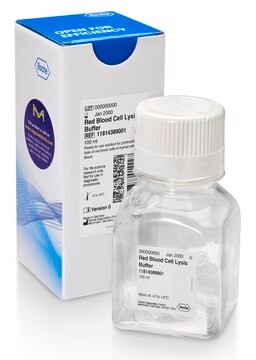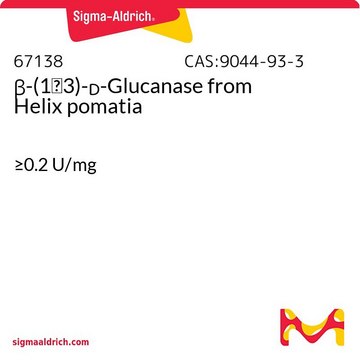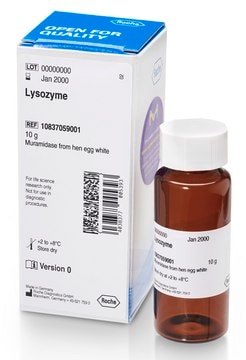17-10050
ChIPAb+ Acetyl-Histone H3 (Lys4) - ChIP Validated Antibody and Primer Set
from rabbit, purified by affinity chromatography
別名:
H3K4Ac, Histone H3 (acetyl K4), H3 histone family, member T, histone 3, H3, histone cluster 3, H3
ログイン組織・契約価格を表示する
すべての画像(5)
About This Item
UNSPSCコード:
12352203
eCl@ss:
32160702
NACRES:
NA.52
おすすめの製品
詳細
All ChIPAb+ antibodies are individually validated for chromatin precipitation, every lot, every time. Each ChIPAb+ antibody set includes control primers (tested every lot by qPCR) to biologically validate your IP results in a locus-specific context. The qPCR protocol and primer sequences are provided, allowing researchers to validate ChIP protocols when using our antibody in their chromatin context. Each set also includes a negative control antibody to ensure specificity of the ChIP reaction.
The ChIPAb+ Acetyl-Histone H3 (Lys4) set includes the Acetyl-Histone H3 (Lys4) antibody, a negative control antibody (normal rabbit IgG), and qPCR primers which amplify a 166 bp region of human GAPDH. The Acetyl-Histone H3 (Lys4) and negative controls are supplied in a scalable "per ChIP" reaction size and can be used to functionally validate the precipitation of Acetyl-Histone H3 (Lys4)-associated chromatin.
The ChIPAb+ Acetyl-Histone H3 (Lys4) set includes the Acetyl-Histone H3 (Lys4) antibody, a negative control antibody (normal rabbit IgG), and qPCR primers which amplify a 166 bp region of human GAPDH. The Acetyl-Histone H3 (Lys4) and negative controls are supplied in a scalable "per ChIP" reaction size and can be used to functionally validate the precipitation of Acetyl-Histone H3 (Lys4)-associated chromatin.
Histone H3 is one of the five main histone proteins involved in the structure of chromatin in eukaryotic cells. Featuring a main globular domain and a long N-terminal tail, H3 is involved with the structure of the nucleosomes of the ′beads on a string′ structure. Histone proteins are highly post-translationally modified, and Histone H3 is the most extensively modified of the five histones. The term "Histone H3" alone is purposely ambiguous in that it does not distinguish between sequence variants or modification state. Histone H3 is an important protein in the emerging field of epigenetics, where its sequence variants and variable modification states are thought to play a role in the dynamic and long term regulation of genes.
特異性
Recognizes Histone H3 acetylated on Lys4.
Wide range of cross-reactivity expected based on sequence homology.
免疫原
Epitope: Acetylated Lys4
KLH-conjugated, synthetic peptide containing the sequence …RTAcKQ… in which AcK corresponds to acetyl lysine 4 of human histone H3.
アプリケーション
Research Category
エピジェネティクス及び核内機能分子
エピジェネティクス及び核内機能分子
Research Sub Category
ヒストン
ヒストン
Chromatin Immunoprecipitation:
Sonicated chromatin prepared from HeLa cells (1 X 106 cell equivalents per IP) were subjected to chromatin immunoprecipitation using 4 µL of Normal rabbit IgG or 4 µL Anti-Acetyl-Histone H3 (Lys4) and the Magna ChIP® A Kit (Cat. # 17-610).
Successful immunoprecipitation of Acetyl-Histone H3 (Lys4) associated DNA fragments was verified by qPCR using Control Primers as a positive locus on the GAPDH promoter, and β-Globin primers as a negative locus. (Please see figures).
Data is presented as percent input of each IP sample relative to input chromatin for each amplicon and ChIP sample as indicated.
Please refer to the EZ-Magna ChIP A (Cat. # 17-408) or EZ-ChIP (Cat. # 17-371) protocol for experimental details.
Western Blot Analysis:
Representative lot data.
Recombinant histone H3 (Catalog # 14-411, lane 1) and acid extracts from sodium butyrate treated (lane 2) and untreated (lane 3) HeLa cells (Catalog # 17-305) were resolved by electrophoresis, transferred to nitrocellulose and probed with anti-acetyl-Histone H3 (Lys4) (1:1,000 dilution).
Proteins were visualized using a goat anti-rabbit secondary antibody conjugated to HRP and a chemiluminescence detection system. (Please see pictures).
Histone-Peptide Specificity Assay: Representative lot data.
A 1:1,000 – 1:5,000 dilution of anti-acetyl Histone H3 (Lys4) was incubated with a cocktail of microspheres conjugated to histone H3
peptides with the following modifications:
1. Unmodified, containing Lys 4, 9, 14 and 18
2. Acetyl-lysine 4
3. Acetyl-lysine 9
4. Acetyl-lysine 14
5. Acetyl-lysine 18
6. Acetyl-lysine 23
7. Acetyl-lysine 27
Unbound antibody was then removed by filtration. Peptide-antibody complexes were incubated with a biotin-conjugated anti-rabbit secondary antibody followed by incubation with a phycoerythrin-streptavidin conjugate. Fluorescence was read on a Luminex 100 instrument.
Median Fluorescence Intensity (MFI) is plotted (Please see figures).
Sonicated chromatin prepared from HeLa cells (1 X 106 cell equivalents per IP) were subjected to chromatin immunoprecipitation using 4 µL of Normal rabbit IgG or 4 µL Anti-Acetyl-Histone H3 (Lys4) and the Magna ChIP® A Kit (Cat. # 17-610).
Successful immunoprecipitation of Acetyl-Histone H3 (Lys4) associated DNA fragments was verified by qPCR using Control Primers as a positive locus on the GAPDH promoter, and β-Globin primers as a negative locus. (Please see figures).
Data is presented as percent input of each IP sample relative to input chromatin for each amplicon and ChIP sample as indicated.
Please refer to the EZ-Magna ChIP A (Cat. # 17-408) or EZ-ChIP (Cat. # 17-371) protocol for experimental details.
Western Blot Analysis:
Representative lot data.
Recombinant histone H3 (Catalog # 14-411, lane 1) and acid extracts from sodium butyrate treated (lane 2) and untreated (lane 3) HeLa cells (Catalog # 17-305) were resolved by electrophoresis, transferred to nitrocellulose and probed with anti-acetyl-Histone H3 (Lys4) (1:1,000 dilution).
Proteins were visualized using a goat anti-rabbit secondary antibody conjugated to HRP and a chemiluminescence detection system. (Please see pictures).
Histone-Peptide Specificity Assay: Representative lot data.
A 1:1,000 – 1:5,000 dilution of anti-acetyl Histone H3 (Lys4) was incubated with a cocktail of microspheres conjugated to histone H3
peptides with the following modifications:
1. Unmodified, containing Lys 4, 9, 14 and 18
2. Acetyl-lysine 4
3. Acetyl-lysine 9
4. Acetyl-lysine 14
5. Acetyl-lysine 18
6. Acetyl-lysine 23
7. Acetyl-lysine 27
Unbound antibody was then removed by filtration. Peptide-antibody complexes were incubated with a biotin-conjugated anti-rabbit secondary antibody followed by incubation with a phycoerythrin-streptavidin conjugate. Fluorescence was read on a Luminex 100 instrument.
Median Fluorescence Intensity (MFI) is plotted (Please see figures).
This ChIPAb+ Acetyl-Histone H3 (Lys4) -ChIP Validated Antibody & Primer Set conveniently includes the antibody & the specific control PCR primers.
包装
25 assays per set. Recommended use: ~4 μL of antibody per chromatin immunoprecipitation (dependent upon biological context).
構成
Anti-Acetyl-Histone H3 (Lys4) (rabbit polyclonal)
Normal Rabbit IgG
Control Primers
Normal Rabbit IgG
Control Primers
品質
Chromatin Immunoprecipitation:
Sonicated chromatin prepared from HeLa cells (1 X 106 cell equivalents per IP) were subjected to chromatin immunoprecipitation using 4 µL of Normal Rabbit IgG or 4 µL Anti-Acetyl-Histone H3 (Lys4) and the Magna ChIP® A Kit (Cat. # 17-610). Successful immunoprecipitation of Acetyl-Histone H3 (Lys4) associated DNA fragments was verified by qPCR using Control Primers (Please see figures).
Please refer to the EZ-Magna ChIP A (Cat. # 17-408) or EZ-ChIP (Cat. # 17-371) protocol for experimental details.
Sonicated chromatin prepared from HeLa cells (1 X 106 cell equivalents per IP) were subjected to chromatin immunoprecipitation using 4 µL of Normal Rabbit IgG or 4 µL Anti-Acetyl-Histone H3 (Lys4) and the Magna ChIP® A Kit (Cat. # 17-610). Successful immunoprecipitation of Acetyl-Histone H3 (Lys4) associated DNA fragments was verified by qPCR using Control Primers (Please see figures).
Please refer to the EZ-Magna ChIP A (Cat. # 17-408) or EZ-ChIP (Cat. # 17-371) protocol for experimental details.
ターゲットの説明
~17 kDa
物理的形状
Affinity purified
Anti-Acetyl-Histone H3 (Lys4) (rabbit polyclonal). One vial containing 100 µL of immunoaffinity purified rabbit polyclonal in storage buffer containing 0.05% sodium azide with 30% glycerol. Store at -20°C.
Normal Rabbit IgG. One vial containing 125 µg Rabbit IgG in 125 µL storage buffer containing 0.05% sodium azide. Store at -20°C.
Control Primers. One vial containing 75 μL of 5 μM each primer specific for human GAPDH. Store at -20°C.
FOR: TAC TAG CGG TTT TAC GGG CG
REV: TCG AAC AGG AGG AGC AGA GAG CGA
Normal Rabbit IgG. One vial containing 125 µg Rabbit IgG in 125 µL storage buffer containing 0.05% sodium azide. Store at -20°C.
Control Primers. One vial containing 75 μL of 5 μM each primer specific for human GAPDH. Store at -20°C.
FOR: TAC TAG CGG TTT TAC GGG CG
REV: TCG AAC AGG AGG AGC AGA GAG CGA
保管および安定性
Stable for 1 year at -20°C from date of receipt. Handling Recommendations: Upon first thaw, and prior to removing the cap, centrifuge the vial and gently mix the solution. Aliquot into microcentrifuge tubes and store at -20°C. Avoid repeated freeze/thaw cycles, which may damage IgG and affect product performance. Note: Variability in freezer temperatures below -20°C may cause glycerol containing solutions to become frozen during storage.
アナリシスノート
Control
Includes negative control antibody and primers specific for human GAPDH.
Includes negative control antibody and primers specific for human GAPDH.
法的情報
MAGNA CHIP is a registered trademark of Merck KGaA, Darmstadt, Germany
UPSTATE is a registered trademark of Merck KGaA, Darmstadt, Germany
免責事項
Unless otherwise stated in our catalog or other company documentation accompanying the product(s), our products are intended for research use only and are not to be used for any other purpose, which includes but is not limited to, unauthorized commercial uses, in vitro diagnostic uses, ex vivo or in vivo therapeutic uses or any type of consumption or application to humans or animals.
保管分類コード
10 - Combustible liquids
適用法令
試験研究用途を考慮した関連法令を主に挙げております。化学物質以外については、一部の情報のみ提供しています。 製品を安全かつ合法的に使用することは、使用者の義務です。最新情報により修正される場合があります。WEBの反映には時間を要することがあるため、適宜SDSをご参照ください。
Jan Code
17-10050:
試験成績書(COA)
製品のロット番号・バッチ番号を入力して、試験成績書(COA) を検索できます。ロット番号・バッチ番号は、製品ラベルに「Lot」または「Batch」に続いて記載されています。
Emily R Albright et al.
Journal of virology, 87(17), 9802-9812 (2013-07-05)
Human cytomegalovirus (HCMV) is a significant human pathogen that achieves lifelong persistence by establishing latent infections in undifferentiated cells of the myeloid lineage, such as CD34(+) hematopoietic progenitor cells. When latency is established, viral lytic gene expression is silenced in
ライフサイエンス、有機合成、材料科学、クロマトグラフィー、分析など、あらゆる分野の研究に経験のあるメンバーがおります。.
製品に関するお問い合わせはこちら(テクニカルサービス)







